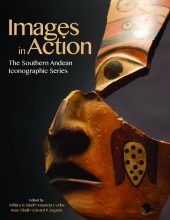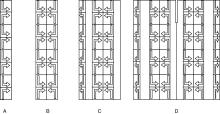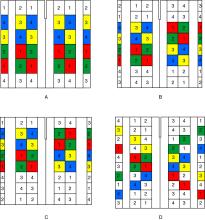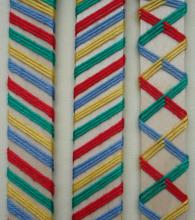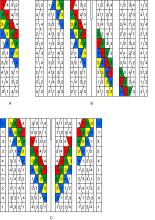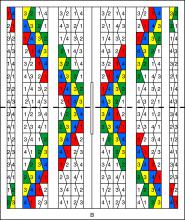Visual database
Mirror symmetry in four-part creature tunics. (a) Root pattern (rare); (b) standard band pattern; (c) panel pattern; (d) pattern on tunic front.
The root color pattern for tunics displaying four-part creatures is reproduced in the checkerboard wrapped specimen (left), and in a shorthand version made with fewer threads (right).
Deriving color patterns in the four-part creature tunics. (a) Linear sequence in a single band (rare); (b) linear sequence and its inversion in a doubled band (standard); (c) panel pattern extended by exact repetition; (d) panel pattern extended by offsetting.
Variations introduced at the center seam in the color patterns on four-part creature tunics. (a) Private collection (Benavides 1999:385); (b) TM 91.533 (tunic in Figure 24.12, left); (c) MNAAH RT 3565; (d) TM 1962.5.1 (tunic in Figure 24.12, right).
The root color patterns in face and fret tunics correspond with diagonal pathways produced in thread wrapping. Parallel diagonal pathways can be Z or S slant (left and center) and opposed diagonal pathways alternate in being S and Z slant (right).
The pattern of parallel color diagonals on face and fret tunics. (a) The root pattern in a band; (b) continuous across the center seam (AIC 1985.1784); (c) reversing at the center seam (FM 241835, after Bergh 1999:Figure 12.1).
The pattern of opposed color diagonals on face and fret tunics. (a) The root pattern in a band; (b) continuous across the center seam (LACMA M77.70.3, after Bergh 1999:Figure 7.1); (c) reversing at the center seam (TM 1962.28.1).
The pattern of parallel diagonals on face and fret tunics with reversals at the center seam and shoulder line. (a) MfVM 18/1363 (after Stone 1987:Figure 3-33).
The pattern of parallel diagonals on face and fret tunics with reversals at the center seam and shoulder line. (b) BMA 41.229 (after Bergh 1999:Figure 10.1).
Examples of color patterns in figurative tunics, reproduced in wrapping; two-color checkerboard (left); opposed diagonals with four colors (right).
